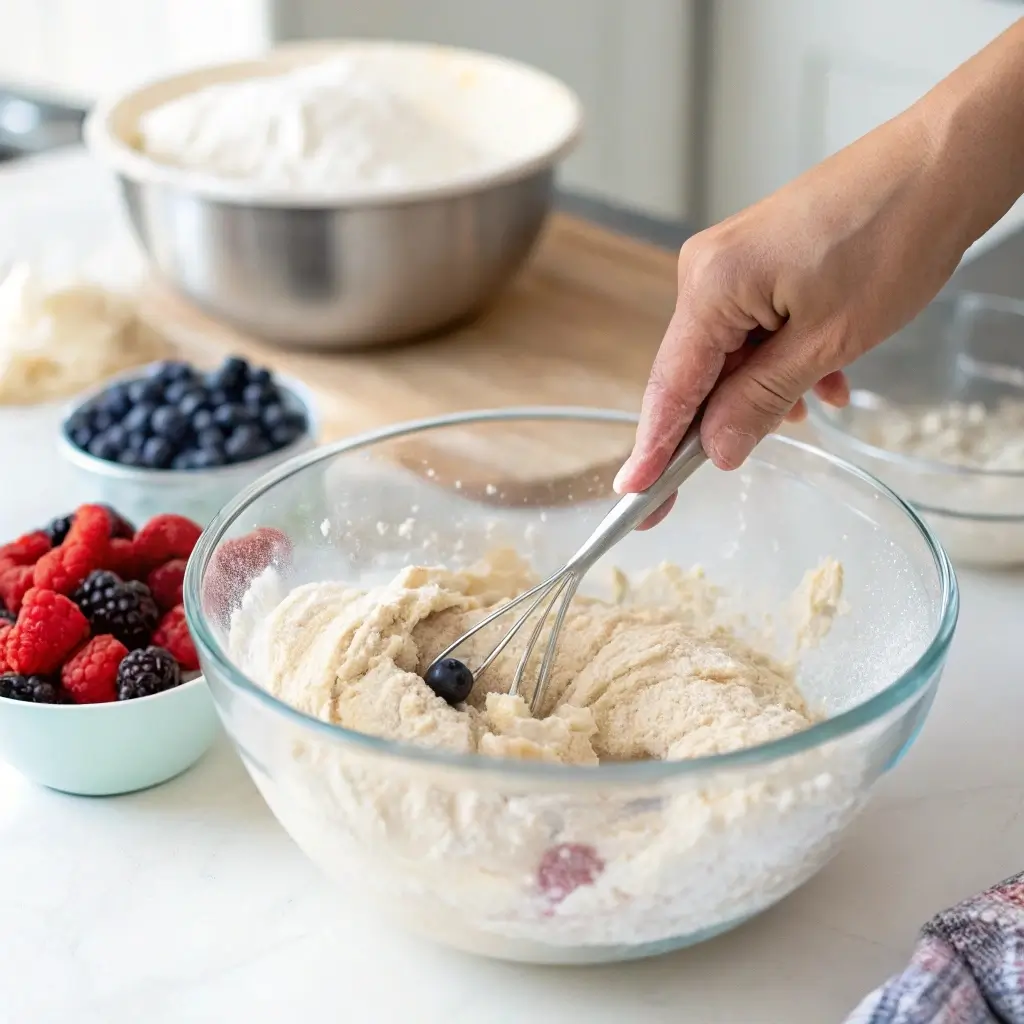If you’ve ever sliced into a warm loaf of blueberry sourdough bread, you know it’s more than just bread—it’s a moment. The golden crust gives way to a soft, tangy crumb filled with juicy blueberry bursts. This recipe became a staple in my Santa Barbara kitchen while raising two picky twin boys who swore off fruit. One morning, I folded berries into my basic sourdough out of desperation. What came out of the oven? A fruity, tangy masterpiece they devoured without question.
This guide walks you through how to recreate that experience at home—from my go-to hydration tips to pairing suggestions. Whether you’re already baking multigrain sourdough bread or curious about the benefits of organic sourdough, this recipe delivers a beautiful blend of bold flavor, family history, and seasonal comfort.
Table of Contents

How blueberry sourdough became a family weekend favorite
Hi, I’m Lisa Hartwell—a 53-year-old home cook from sunny Santa Barbara, California. My love for blueberry sourdough bread didn’t start in a bakery—it began in a tiny kitchen filled with messy counters and the sound of twin boys complaining about “weird fruit.” As a single mom, I had one mission: make healthy food that didn’t feel like a fight.
One weekend, I tossed leftover sourdough starter with a handful of overripe blueberries and hoped for the best. What came out of the oven was anything but ordinary. The crust was golden and crisp, the inside bursting with tangy bubbles and pockets of sweet berry juice. That loaf vanished before it had a chance to cool. From that moment on, blueberry sourdough became our weekend tradition.
I’d prep it Friday night, bulk ferment it on Saturday, and bake it fresh Sunday morning. The boys would slather it with almond butter or cream cheese while I’d sneak a slice with lemon curd and coffee. That humble loaf turned into a ritual we all looked forward to—right alongside our love for sourdough pita bread and other weekly staples.
What makes blueberry sourdough bread uniquely crave-worthy
Blueberry sourdough bread hits the sweet spot between comfort and complexity. The sourdough fermentation gives it depth and chew, while the berries add pockets of brightness. It’s naturally sweet without added sugar, and it pairs well with both savory and sweet toppings. I often use lemon zest in the dough, which echoes techniques I talk about in my croissant sourdough bread post—it adds just enough lift to brighten the whole loaf.
Mastering the Dough: How to Make Blueberry Sourdough Bread
Tips for the perfect hydration and fermentation balance
If you’ve ever baked blueberry sourdough bread, you know that the dough is the foundation of a successful loaf. This bread isn’t just about throwing berries into your mix—it’s about creating balance. Start with an active sourdough starter that’s bubbly and ready to go. I usually let mine ferment about 5 hours after feeding.
For a soft, airy crumb, aim for 75–78% hydration. That means if you’re using 500g of flour, add 375–390g of water. Use bread flour to support structure, especially when you’re folding in fruit. I occasionally blend in a bit of rye, like I do for added depth in my multigrain sourdough bread.
Fermentation is key to any good blueberry sourdough bread. Let it bulk ferment in a covered bowl for 4–6 hours, doing a series of stretch-and-folds every 30 minutes during the first half. These folds strengthen your dough without overmixing—ideal when berries will be added later.
Bakers Schedule (example)
- 9am – feed your starter
- 5 pm – assemble your dough
- 6 pm – first stretch and fold
- 7 pm – second stretch and fold
- 8 pm – third stretch and fold
- 9 pm – fourth stretch and folds + adding butterfly pea powder
- Let rest on the counter overnight
- 7am – add goat cheese + shape your dough, put in the fridge
- 10 am – bake your bread
- lunch time, enjoy your bread!

How and when to add fresh or dried blueberries
The timing of the berries makes or breaks your blueberry sourdough bread. Add them after the first or second fold to avoid excessive moisture. Fresh or frozen blueberries should be patted dry and tossed in flour before being gently folded into the dough. This prevents them from bursting and turning your dough purple and wet.
If you’re after intense flavor, try rehydrating dried blueberries in citrus juice before adding them. It’s a trick I picked up while testing enriched doughs like croissant sourdough bread.
By the time you shape your loaf and transfer it to a banneton, your dough should be sturdy but relaxed. Once baked, your blueberry sourdough bread will have a crackly crust, an open crumb, and those signature bursts of sweet-tart fruit throughout.

Flavor Pairings and Serving Ideas for Blueberry Sourdough Bread
Sweet and savory ways to enjoy blueberry sourdough bread
Once your blueberry sourdough bread is baked, the real fun begins—eating it. This isn’t just any breakfast loaf. It’s versatile enough to be the star of your table from sunrise to sunset.
For mornings, toast slices and top them with almond butter, a drizzle of honey, or Greek yogurt with a dusting of cinnamon. If you’re craving something cozy, try it French-toast style, dipped in egg and fried golden. The tangy sourdough paired with warm blueberries tastes just like a morning hug.
For savory moments, surprise your taste buds. I love spreading goat cheese on toasted blueberry sourdough bread and topping it with fresh thyme and cracked black pepper. The mix of creamy, herby, and sweet-sour flavors is unexpectedly delightful. If you’re serving brunch, pair this bread with a soft scrambled egg and arugula salad—simple, fresh, and elegant.
We’ve served it alongside creamy soups and even used it as the base for a dessert bread pudding. (Yes, it holds up beautifully.) It reminds me of how versatile gluten-free garlic bread can be—different flavor profile, but just as adaptable.
Perfect pairings: butters, jams, and cheese suggestions
The best partners for blueberry sourdough bread? Let’s talk spreads. Softened butter is always a win, but compound butters take things further. Try one with lemon zest and sea salt, or a whipped cinnamon-maple version.
Jams work beautifully too. Blueberry pairs well with lemon preserves, raspberry, or even fig jam. If you’re into cheese boards, don’t skip this bread—brie, mascarpone, or even a sharp white cheddar balance out the berries with richness and tang. It’s a pairing idea I touch on in my post about how to build sourdough-friendly snacks.
No matter how you slice it, blueberry sourdough bread is more than a loaf—it’s the canvas for flavors that stretch from indulgent to wholesome.
For more fun variations and ideas, check out our Facebook and Pinterset sections where creativity meets craving.

Blueberry Sourdough Bread
Ingredients
Equipment
Method
- Feed your sourdough starter around 9am and let it become bubbly and active for 5 hours.
- At 5pm, mix flour, water, and starter until combined. Let rest (autolyse) for 30 minutes, then add salt.
- Perform four stretch-and-folds at 30-minute intervals starting at 6pm. Add blueberries after the second fold around 7:30pm.
- At 9pm, optionally add lemon zest or goat cheese. Shape the dough and place in a floured banneton.
- Cover and refrigerate overnight for cold fermentation (around 10–12 hours).
- In the morning (around 10am), preheat oven with Dutch oven inside to 475°F (245°C). Score the dough and transfer it into the Dutch oven.
- Bake covered for 20 minutes, then uncovered for 25 minutes more until crust is golden brown. Cool completely before slicing.
Nutrition
Notes
Tried this recipe?
Let us know how it was!Storage, Nutrition & FAQs Answered
Is blueberry sourdough good for you? Health and fiber facts
Not only is blueberry sourdough bread delicious—it’s surprisingly nutritious too. Thanks to natural fermentation, sourdough is often easier to digest than conventional bread. The live cultures help break down gluten, which can be gentler on the gut for some eaters. Combined with antioxidant-rich blueberries, this bread brings both flavor and benefits to the table.
Blueberries are packed with vitamin C, fiber, and anti-inflammatory compounds. Each slice of blueberry sourdough bread offers a balanced source of energy, especially when paired with healthy fats like nut butter or avocado. Unlike many sweet breads, this one doesn’t rely on added sugar. The fruit and fermentation create enough natural sweetness and complexity.
If you’re following a mindful eating plan, it’s a great alternative to processed options. For those looking to reduce carbs or follow dietary guidelines, you might want to check out my take on low-FODMAP sourdough bread for a lighter variation.
How to store, slice, and revive leftover blueberry sourdough
Once you’ve baked a beautiful loaf of blueberry sourdough bread, keeping it fresh is key. Let it cool completely before slicing—it continues cooking internally as it rests. Use a sharp serrated knife and slice only what you’ll eat to preserve the crumb’s texture.
To store, wrap it in a clean tea towel or place it in a paper bag. Keep it at room temperature for up to 3 days. For longer storage, slice the whole loaf and freeze it. You can toast slices directly from frozen and still enjoy a crisp crust and tender crumb.
To revive a slightly stale slice, spritz it with a little water and warm it in the oven for 5–6 minutes at 350°F. It brings the crust back to life—just like I recommend for refreshing other rustic breads, including the sourdough pita bread that we love in summer wraps.
FAQs About Blueberry Sourdough Bread
Why do people love sourdough bread?
Sourdough bread offers a rich, tangy flavor that’s hard to replicate. The natural fermentation not only creates a signature chewy texture but also improves digestibility. People also love the artisanal feel and slower process that comes with sourdough baking. Whether it’s a simple loaf or something more flavorful like blueberry sourdough bread, it brings both taste and tradition to the table.
Is sourdough bread good for people?
Yes—especially when made at home. Sourdough contains live cultures, lower levels of gluten, and beneficial acids that help regulate blood sugar. When berries are added, like in blueberry sourdough bread, it also provides natural sweetness and antioxidants without processed ingredients. It’s a wholesome option for most diets.
Why do so many people eat sourdough bread?
Sourdough is gaining popularity because it’s both versatile and nourishing. It fits a range of lifestyles, from vegan to low-sugar. Its fermentation process also boosts flavor in ways standard bread can’t. Recipes like blueberry sourdough bread expand that appeal by blending health benefits with fruity indulgence.
How to eat blueberry sourdough?
Blueberry sourdough bread is incredibly flexible. Eat it toasted with cream cheese or butter for breakfast, or turn it into French toast. It also pairs well with soft cheeses, nut butters, and even savory spreads. Serve it fresh or warm it up slightly to enjoy the full burst of blueberry flavor in every bite.
Conclusion
Blueberry sourdough bread is more than a recipe—it’s a celebration of flavor, tradition, and creativity. Whether you’re trying to get your kids to eat more fruit (been there!) or just want something beautiful and homemade for your weekend brunch, this bread delivers.
From fermentation tips to perfect pairings, you now have everything you need to bake with confidence. Remember, even if your first loaf isn’t picture-perfect, it’s baked with love—and that always tastes amazing. So grab your starter, fold in those berries, and let’s make something unforgettable.
